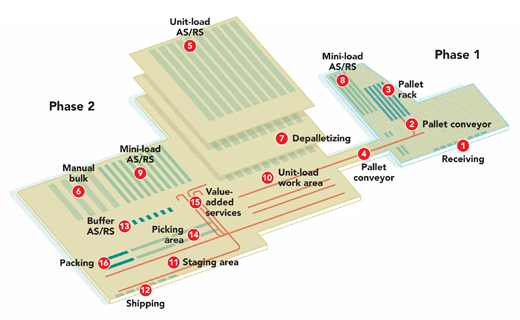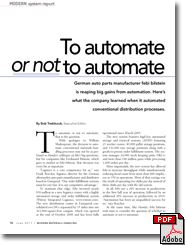Automation in high gear at febi bilstein
Febi’s new distribution center uses unit- and tote-handling automated storage, conveyor and goods-to-person picking in an ergonomic work environment.
Latest Logistics News
FTR’s Trucking Conditions Index falls to lowest level since last September U.S. rail carload and intermodal volumes are mixed, for week ending May 11, reports AAR Cass Freight Index points to annual shipments and expenditures declines ALAN opens up its nominations for 2024 Humanitarian Logistics Awards U.S.-bound import growth remains intact in April, reports Descartes More NewsFerdinand Bilstein,
Ennepetal, Germany
Size: 130,850 square feet in existing building/231,425 square feet in new center for a total of 362,275 square feet
Products: Car and truck parts for the independent aftermarket
SKUs: 24,000
Throughput: 1,000 orders per day
Shifts: 2 shifts/5 days
Employees: 350 to 400 in operations
A high-bay, unit-load automated storage and retrieval system (AS/RS) and tote-handling mini-load storage systems are the primary components of febi bilstein’s logistics center in Ennepetal. The logistics center is comprised of two buildings completed in two phases. In Phase 1, febi converted its original conventional warehouse into an automated logistics center. Phase 2, which is connected to the original building by a bridge, was built later and is responsible for the majority of the order fulfillment.
The system uses sophisticated order fulfillment software to deliver pallets and totes to order selectors in sequence with a goods-to-person order fulfillment scenario. The result is a system that can handle increased order volume, higher throughputs and improved customer service levels without adding labor.
Receiving: Inbound pallets are typically received (1) in the Phase 1 building. Pallets are staged in the receiving area and scanned into the warehouse management system (WMS) and checked by the quality assurance department. The WMS then determines a storage location.
Putaway: From the receiving area, slow-moving pallets are stored in a pallet rack in the manual area in Phase 1. The remaining pallets are placed on a pallet handling conveyor (2). Pallets that remain in Phase 1 are inducted into the unit-load AS/RS (3). Pallets destined for the Phase 2 building travel by conveyor across a connecting bridge (4), where they are received and inducted into the unit-load AS/RS (5).
Oversized pallets that may not fit in either AS/RS are stored in pallet rack in a manual bulk area (6). In either case, once pallets have been putaway into storage, they are available to promise.
Replenishment: Items that will be piece picked or placed in an inner pack are stored in one of two tote-handling mini-load AS/RS systems. To replenish the mini-load systems, pallets are delivered from the unit-load AS/RS (5) to a depalletizing area (7). There items are depalletized and placed into totes. Once complete, the totes are inducted into the mini-load AS/RS system in Phase 1 (8) or Phase 2 (9).
Picking: Orders may include full pallet or mixed pallet shipments. Either way, pallets are delivered by the AS/RS to a workstation (10). Full pallets are picked up and transported directly to a staging location in the shipping area. Otherwise, an order selector will be directed by the system to pull cases from the pallet and place them on a shipping pallet. Once the pallet is complete, it is delivered to a staging location (11) in the shipping area (12).
Totes required for piece picking are delivered from the mini-load AS/RS (9) to smaller mini-load systems (13) in the picking area (14). These are used as buffer storage and to deliver totes to the picking stations in the right sequence to fill orders. A display at the workstation tells order selectors which items to pick and in which totes to place them.
Packing: Once a tote is complete, it may be conveyed to a value-added service area (15) for kitting, for customer-required labeling or for any special packaging requirements. Once any value-added services are complete, the items are transported to the packing area (16). There, a cubing algorithm will determine the optimal shipping carton for that order. Once the carton is erected, the packer will place the item into the shipping container.
Shipping: In the staging area (11), parcels and pallets will be married together if they are part of an order. Then, they will be loaded onto an outbound truck in the shipping area (12).


Article Topics
Latest in Logistics
FTR’s Trucking Conditions Index falls to lowest level since last September U.S. rail carload and intermodal volumes are mixed, for week ending May 11, reports AAR Cass Freight Index points to annual shipments and expenditures declines ALAN opens up its nominations for 2024 Humanitarian Logistics Awards U.S.-bound import growth remains intact in April, reports Descartes Looking at a reshoring history lesson NTSB: Ship lost power twice before slamming into Baltimore bridge, closing port More LogisticsAbout the Author
Subscribe to Logistics Management Magazine

Find out what the world's most innovative companies are doing to improve productivity in their plants and distribution centers.
Start your FREE subscription today.
May 2024 Logistics Management

Latest Resources















